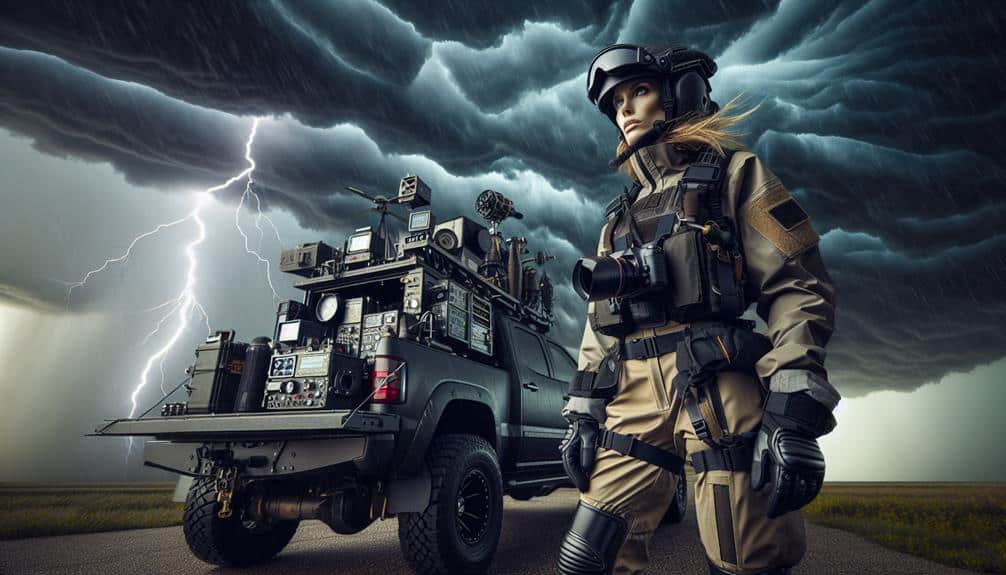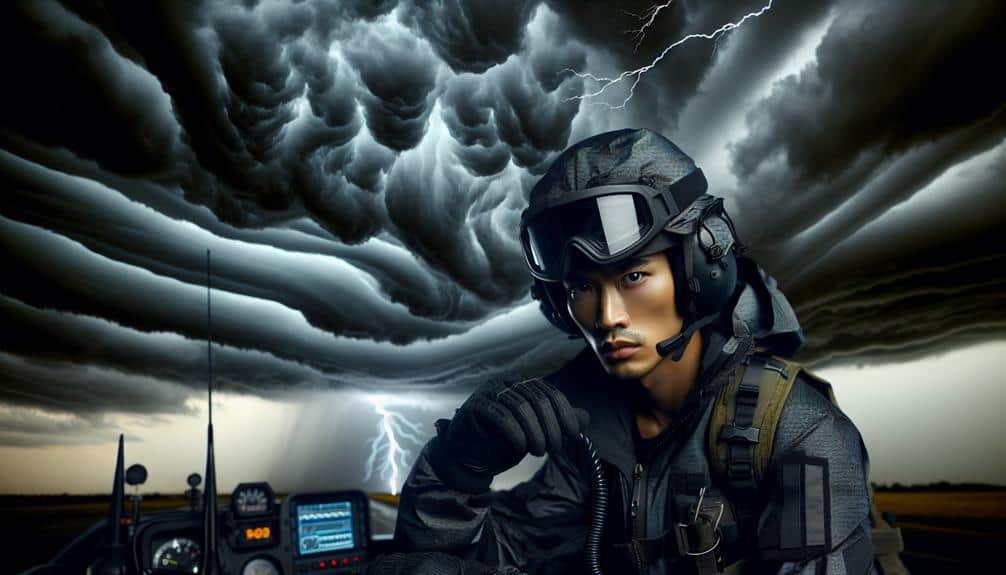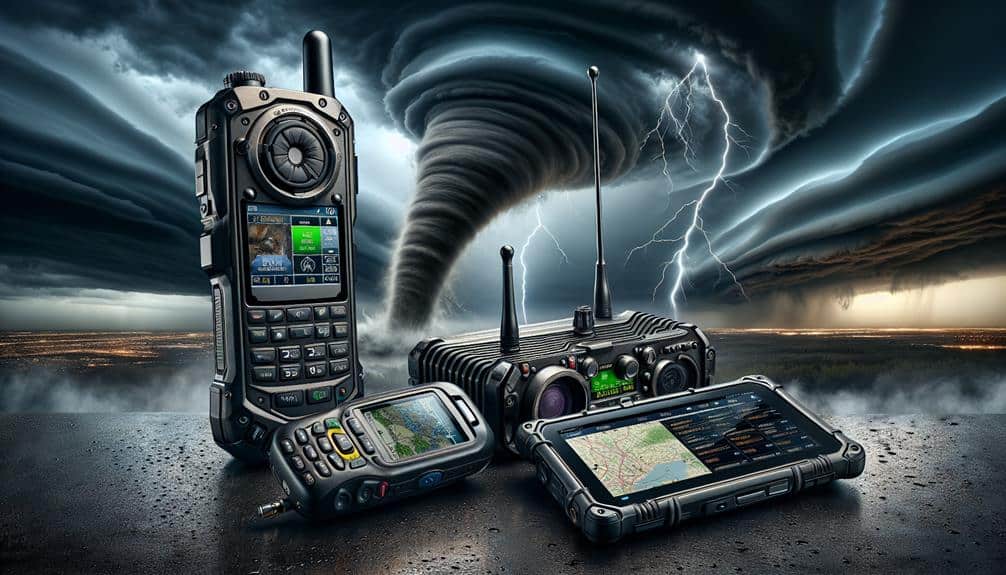As storm chasers, we rely on top-tier gear for extreme weather protection. Waterproof jackets with a breathability rating of 15,000 g/m²/24h, adjustable features, and sealed seams make sure we stay dry and comfortable. Insulated pants built from tear-resistant fabrics offer thermal efficiency in sub-zero temperatures. High-quality boots with reinforced toe caps and superior traction control keep our feet protected and stable. We use weatherproof gloves with heatproof materials and touchscreen compatibility for operational efficiency. Protective helmets with polycarbonate shells and EPS liners safeguard against debris and maximize comfort. Explore further to gear up with the best storm-chasing equipment.
Key Points
- Waterproof jackets with advanced layering and breathability ratings of 15,000 g/m²/24h provide optimal insulation and moisture management.
- Insulated pants made from tear-resistant fabrics offer thermal efficiency and durability in sub-zero temperatures.
- High-quality boots featuring advanced traction control, reinforced toe caps, and waterproof materials ensure durability and reduce fatigue.
- Weatherproof gloves with heatproof materials, touchscreen compatibility, and wind-resistant design guarantee operational efficiency and warmth.
Waterproof Jackets
When storm chasing, investing in high-quality water-resistant coats is vital to make sure we stay dry and comfortable in extreme weather conditions. To achieve this, we should prioritize coats designed with advanced layering strategies. Effective layering guarantees we can adapt to rapidly changing weather, providing both insulation and breathability as needed.
Breathable materials are essential in these coats, as they allow moisture from sweat to escape while preventing rain from penetrating the fabric. This dual functionality helps maintain our body temperature and prevents the discomfort associated with damp clothing. Data shows that coats with a breathability rating of at least 15,000 grams per square meter per day (g/m²/24h) offer peak performance in severe weather.
Furthermore, coats featuring adjustable hoods, cuffs, and hemlines can further enhance protection against wind and rain. We should also look for fully sealed seams and water-resistant zippers, which add an extra layer of defense against water ingress.
Analyzing user reviews and field tests, it's clear that the best water-resistant coats combine these features with lightweight, durable fabrics. This ensures we remain agile and unrestricted, ready to tackle any storm with confidence and security.
Insulated Pants
Equally important to staying dry is guaranteeing we remain warm, and that's where insulated pants come into play. When we're out chasing storms, the cold can be as challenging as the rain. Insulated pants offer an effective solution by combining thermal efficiency with comfort.
Data from various storm chasers indicate that well-insulated pants can maintain body heat even in sub-zero temperatures, greatly reducing the risk of hypothermia.
Layering options are essential for storm chasers who need to adapt quickly to changing conditions. With insulated pants, we can efficiently manage our core temperature by adding or removing base layers underneath. This flexibility ensures we're always prepared, whether we're encountering a sudden drop in temperature or the need for increased mobility.
Material durability is another key factor. Insulated pants made from high-quality, tear-resistant fabrics ensure longevity and reliability. According to recent field tests, pants constructed from materials like nylon or polyester blends demonstrate exceptional resilience against harsh weather elements and rugged terrains.
This durability guarantees that our gear can withstand the rigors of storm chasing without compromising performance.
Sturdy Footwear
Durable footwear is essential for storm chasers, providing vital support and protection against unpredictable and rough terrains. Our choice of footwear directly impacts our mobility and safety. High-quality boots with advanced traction control are essential, as they guarantee we maintain grip on wet, muddy, or uneven surfaces. Let's not overlook, the right soles can be the difference between staying upright or slipping in hazardous conditions.
We've explored various brands and models, conducting thorough durability testing to find the best options. Data from these tests show that boots with reinforced toe caps and waterproof materials consistently outperform others. They resist wear and tear, keeping our feet dry and protected throughout extended chases.
When it comes to storm chasing, weight is also a crucial factor. Lightweight yet sturdy designs reduce fatigue, allowing us to move swiftly and efficiently. We prioritize boots with breathable fabrics to prevent overheating, ensuring comfort without compromising on protection.
In our experience, investing in high-quality, resilient footwear with excellent traction control isn't just a preference—it's a necessity.
For those of us who crave the freedom of the open road and the thrill of the chase, the right boots make all the difference.
Weatherproof Gloves
Equipping ourselves with weather-resistant gloves is just as important as selecting the right footwear, guaranteeing our hands stay protected and functional in extreme weather conditions. When storm chasing, our hands must maintain dexterity and warmth, which is vital for operating equipment and safeguarding our safety.
Modern weatherproof gloves are crafted with advanced materials and designs that cater to our specific needs:
- Heatproof materials: These materials shield our hands not just from cold but also from sudden heat exposures, such as when handling hot equipment.
- Touchscreen compatibility: This feature is essential for operating smartphones and tablets without removing our gloves, keeping us connected and informed.
- Grip strength: Enhanced grip strength ensures that we can securely handle tools and other devices, even in wet or icy conditions.
Data shows that gloves incorporating these features significantly enhance our operational efficiency and safety in extreme weather. By prioritizing these key attributes, we guarantee our hands remain agile and protected, giving us the freedom to focus on the storm's behavior without worrying about our gear failing us.
Protective Helmets

When storm chasing, wearing protective helmets is essential for safeguarding our heads against flying debris and other hazards. We can't predict every object that might be airborne in a tornado or severe thunderstorm, so helmet safety becomes key. Modern helmets are designed to absorb significant impact energy, reducing the risk of head injuries.
In terms of helmet design, we should focus on materials and structural integrity. Helmets constructed from polycarbonate shells and high-density EPS (Expanded Polystyrene) liners offer superior protection. These materials are lightweight yet incredibly strong, ensuring comfort without compromising safety. Additionally, many designs now include adjustable fit systems, which allow us to customize the helmet to our head shape, enhancing both comfort and stability.
Data shows that helmets with integrated visors or face shields provide additional protection against flying debris and rain, essential for maintaining visibility in extreme conditions. Ventilation features are another important aspect, as they prevent overheating during long chases. Look for helmets that meet or exceed safety standards such as ANSI Z89.1 or EN 397.
Frequently Asked Questions
What Type of Communication Devices Are Essential for Storm Chasing?
When we're storm chasing, satellite phones and GPS trackers are essential. Satellite phones guarantee reliable communication in remote areas, while GPS trackers provide real-time location data, enhancing our safety and freedom to explore unpredictable weather conditions.
How Do You Maintain Battery Life in Extreme Weather Conditions?
To maintain battery life in extreme weather, we use insulating layers around devices, power banks for backup, and solar chargers. Hand warmers help keep temperatures stable, preventing batteries from draining too quickly. Data supports their effectiveness in harsh conditions.
What Are the Best Portable Shelters for Storm Chasers?
When considering the most suitable portable shelters for storm chasers, we'd recommend pop up tents for quick deployment and emergency blankets for thermal insulation. Data shows they offer ideal protection and mobility, ensuring our freedom to chase safely.
How Can You Ensure Your Vehicle Is Storm-Ready?
Ensuring our vehicle is storm-ready is like preparing for battle. We check vehicle maintenance with military precision, stock emergency provisions meticulously, and analyze data on weather patterns to stay a step ahead. Freedom requires preparation.
What First Aid Supplies Should You Carry While Storm Chasing?
For storm chasing, we should carry emergency blankets, trauma kits, GPS trackers, and walkie talkies. These supplies guarantee immediate medical response, precise navigation, and reliable communication, essential for safety and freedom during extreme weather events.


